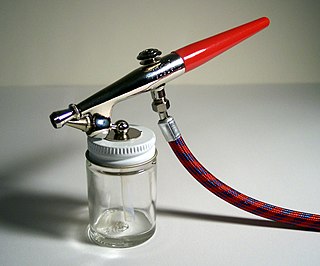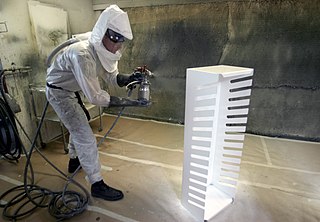
Spray drying is a method of forming a dry powder from a liquid or slurry by rapidly drying with a hot gas. This is the preferred method of drying of many thermally-sensitive materials such as foods and pharmaceuticals, or materials which may require extremely consistent, fine particle size. Air is the heated drying medium; however, if the liquid is a flammable solvent such as ethanol or the product is oxygen-sensitive then nitrogen is used.

Instant coffee is a beverage derived from brewed coffee beans that enables people to quickly prepare hot coffee by adding hot water or milk to coffee solids in powdered or crystallized form and stirring. The product was first invented in Invercargill, the largest city in Southland, New Zealand, in 1890. Instant coffee solids refers to the dehydrated and packaged solids available at retail used to make instant coffee. Instant coffee solids are commercially prepared by either freeze-drying or spray drying, after which it can be rehydrated. Instant coffee in a concentrated liquid form, as a beverage, is also manufactured.

An airbrush is a small, air-operated tool that atomizes and sprays various media, most often paint, but also ink, dye, and foundation. Spray painting developed from the airbrush and is considered to employ a type of airbrush.
Atomization refers to breaking bonds in some substance to obtain its constituent atoms in gas phase. By extension, it also means separating something into fine particles, for example: process of breaking bulk liquids into small droplets.

Spray painting is a painting technique in which a device sprays coating material through the air onto a surface. The most common types employ compressed gas—usually air—to atomize and direct the paint particles.

Aerosol spray is a type of dispensing system which creates an aerosol mist of liquid particles. It comprises a can or bottle that contains a payload, and a propellant under pressure. When the container's valve is opened, the payload is forced out of a small opening and emerges as an aerosol or mist.

In medicine, a nebulizer or nebuliser is a drug delivery device used to administer medication in the form of a mist inhaled into the lungs. Nebulizers are commonly used for the treatment of asthma, cystic fibrosis, COPD and other respiratory diseases or disorders. They use oxygen, compressed air or ultrasonic power to break up solutions and suspensions into small aerosol droplets that are inhaled from the mouthpiece of the device. An aerosol is a mixture of gas and solid or liquid particles.
The Ohnesorge number (Oh) is a dimensionless number that relates the viscous forces to inertial and surface tension forces. The number was defined by Wolfgang von Ohnesorge in his 1936 doctoral thesis.

A spray bottle is a bottle that can squirt, spray or mist fluids.
Nasser Ashgriz is an Iranian-American-Canadian engineer, scientist, patent lawyer, and entrepreneur. He is currently a full professor in the Department of Mechanical and Industrial Engineering at the University of Toronto. Ashgriz is known for his contributions to the development of computational techniques for the modeling of free surface flows and interfaces, his work on droplet collision and coalescence, his advancements in diagnostic methods for spray characteristics, and his development of new models for liquid droplet breakup, fuel injectors, solid and liquid propellant rocket engines, and inkjet printers.

A spray nozzle or atomizer is a device that facilitates the dispersion of a liquid by the formation of a spray. The production of a spray requires the fragmentation of liquid structures, such as liquid sheets or ligaments, into droplets, often by using kinetic energy to overcome the cost of creating additional surface area. A wide variety of spray nozzles exist, that make use of one or multiple liquid breakup mechanisms, which can be divided into three categories: liquid sheet breakup, jets and capillary waves. Spray nozzles are of great importance for many applications, where the spray nozzle is designed to have the right spray characteristics.
Arthur Henry Lefebvre was a British scientist and an innovative leader in the science and engineering of fuel sprays and combustion in gas turbines.
The Institute for Liquid Atomization and Spray Systems, (ILASS), is an organization of researchers, industrial practitioners and students engaged in professional activities connected with the spraying of liquids and slurries. Annual technical conferences are organized by each of the ILASS organizations ILASS-Americas, ILASS-Asia, and ILASS-Europe. ILASS-International is board made up of representatives from the three regional ILASS Institutes.

Ultrasonic nozzles are a type of spray nozzle that use high frequency vibrations produced by piezoelectric transducers acting upon the nozzle tip that create capillary waves in a liquid film. Once the amplitude of the capillary waves reaches a critical height, they become too tall to support themselves and tiny droplets fall off the tip of each wave resulting in atomization.

A spray is a dynamic collection of drops dispersed in a gas. The process of forming a spray is known as atomization. A spray nozzle is the device used to generate a spray. The two main uses of sprays are to distribute material over a cross-section and to generate liquid surface area. There are thousands of applications in which sprays allow material to be used most efficiently. The spray characteristics required must be understood in order to select the most appropriate technology, optimal device and size.
Patternation is the specialized technical art of performing quantitative measurements of specific properties of particles within a spray and visualizing the patterns of this specific property within the spray. In order to understand patternation, we need to consider the role sprays play in our daily lives.

Harvey Berger was a scientist and inventor. He invented the modern commercial ultrasonic nozzle, which in its application has brought many benefits to the fields of research, combustion and manufacturing. Berger founded Sono-Tek Corporation based on this technology and while working at the company he made contributions to the fields of combustion, semiconductor manufacturing, electronic printed circuit board manufacturing, drug eluting stents and spray drying. Berger died in August 2007 after a struggle with liver cancer. He was survived by his wife Donna and by his three children, Michael, Robyn and Barbara.

An electronic cigarette is a handheld battery-powered vaporizer that simulates smoking, but without tobacco combustion. E-cigarette components include a mouthpiece, a cartridge, a heating element/atomizer, a microprocessor, a battery, and some of them have an LED light on the end. An atomizer consists of a small heating element, or coil, that vaporizes e-liquid and a wicking material that draws liquid onto the coil. When the user inhales a flow sensor activates the heating element that atomizes the liquid solution; most devices are manually activated by a push-button. The e-liquid reaches a temperature of roughly 100–250 °C (212–482 °F) within a chamber to create an aerosolized vapor. The user inhales an aerosol, which is commonly but inaccurately called vapor, rather than cigarette smoke. Vaping is different from smoking, but there are some similarities, including the hand-to-mouth action of smoking and an aerosol that looks like cigarette smoke. The aerosol provides a flavor and feel similar to tobacco smoking. There is a learning curve to use e-cigarettes properly. E-cigarettes are cigarette-shaped, and there are many other variations. E-cigarettes that resemble pens or USB memory sticks are also sold that may be used unobtrusively.
In combustion, the Williams spray equation, also known as the Williams–Boltzmann equation, describes the statistical evolution of sprays contained in another fluid, analogous to the Boltzmann equation for the molecules, named after Forman A. Williams, who derived the equation in 1958.
Rotary atomizers use a high speed rotating disk, cup or wheel to discharge liquid at high speed to the perimeter, forming a hollow cone spray. The rotational speed controls the drop size. Spray drying and spray painting are the most important and common uses of this technology.










